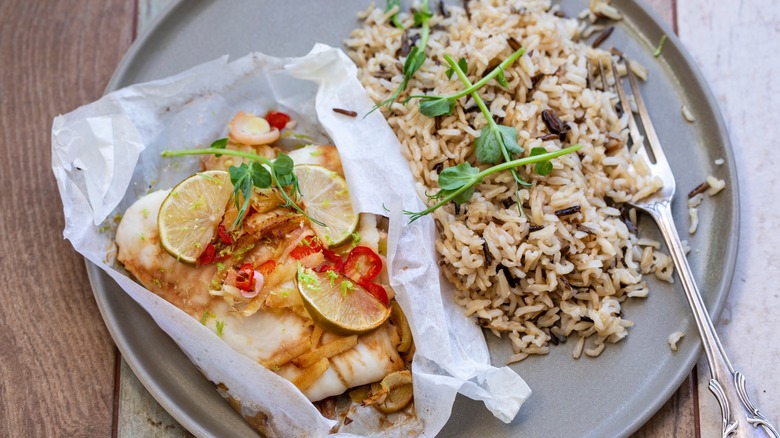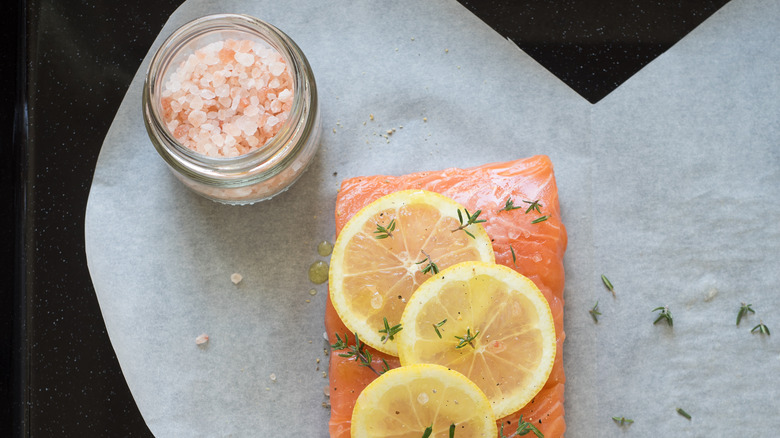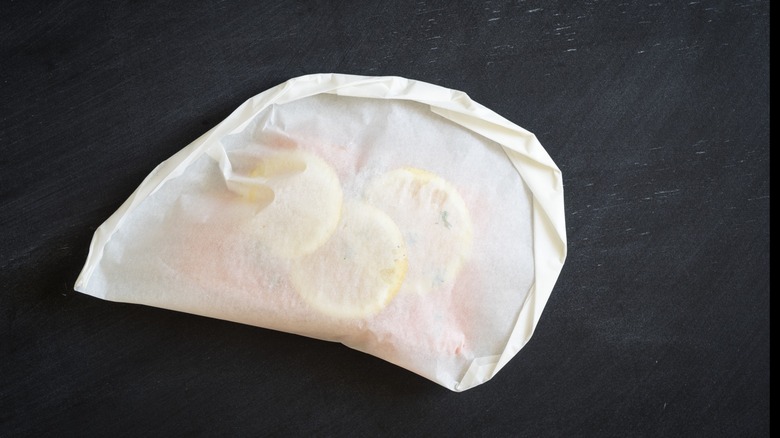The Parchment Packet Method To Bake Irresistibly Tasty Fish
Fish en papillote is the gourmet way of saying fish baked in parchment packets. But don't be intimidated by the fancy French name because this is one of the easiest methods of cooking fish. You're literally just packing the fish — along with other ingredients — in folded parchment paper, popping it in the oven to bake, and you end up with an irresistibly tasty dish.
The reason parchment packs do a great job of cooking fish is because of the micro-environment created by sealing the paper. That encasing ensures the natural juices from the fish and the other ingredients (like vegetables and aromatics) do not escape to the outside. Therefore, your fish turns out juicy and flavorful. You can also think of this setup as a kind of mini-steamer. Because of the steam buildup inside, it cooks the fish gently and evenly while eliminating chances of overcooking.
Besides the flavorsome dish, another advantage of this parchment paper cooking hack is that it's really fun to assemble. Cooking day in and day out can get a bit boring, especially if you're always just working with the same old techniques and methods of cooking. So having to create a pretty little parcel of fish is a welcome change, whether you're cooking a regular weeknight dinner or preparing a celebratory meal for guests. Plus, you get to impress your diners with those packs when you serve them on individual plates.
Assembling the fish parcel
Assembling a fish en papillote is pretty straightforward. Start by gathering the ingredients. Since fish is the star of this dish, make sure you pick the freshest you can find. Any fish will do, from delicate cod, sole, or flounder to a more sturdy salmon and trout. Next, choose your preferred vegetables and then have your aromatics, lemon, herbs, oil, and seasonings ready.
Lay out a parchment paper (or aluminum foil) on a flat work surface. It should be big enough to hold all the ingredients in a small pile yet still leave a couple of inches all around for sealing. Fold and crease the paper halfway to mark the middle point, then flip it back open and start placing the ingredients in the middle of one half. The vegetables go to the bottom, followed by the seasoned fish, then the rest of the ingredients, and then top with a drizzle of cooking oil and a pat of butter.
Fold the empty half of the parchment paper over the stacked ingredients. Create a tight seal by making tiny folds along the open edges from one end to the other — and that's it. Your parchment paper pack is now ready to cook. Place it on a rimmed baking tray and bake it in a preheated oven at 425 degrees Fahrenheit for 12 to 25 minutes. When ready, serve the pouches as is on individual plates and let your guests open the packs for themselves.
Tips for a foolproof fish en papillote
Even the simplest cooking procedures can come with a few surprises that can lead to a failed or subpar dish. For guaranteed success with your fish en papillote, there are a few tips and tricks to keep in your back pocket. Sealing the packet is a critical step, but only folding the parchment paper edges may not be sufficient. To add another layer of insurance, you can either brush some melted butter or cooking oil on the paper or egg whites to serve as a kind of glue that'll keep the parchment paper layers together and enhance the sealing effect when you fold and crimp the edges.
When choosing vegetables to add to your en papillote, pick ones that can steam as quickly as the fish, so you don't end up with undercooked veggies (if crunchy is not what you're aiming for). Some great options are halved cherry tomatoes, spinach, green beans, and asparagus. For sturdier veggies like potatoes, carrots, and zucchini, either thinly slice them first or parboil them beforehand.
When the baking time is up and you're still not sure if the fish is ready, how do you check for doneness without opening the whole parchment packet? The best way is to get the internal temperature reading by poking a digital thermometer through the parchment paper and into the center of the fish (the target temperature for doneness is 145 degrees Fahrenheit).


